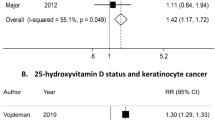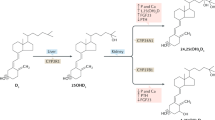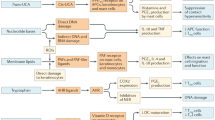Abstract
Melanin has several physiological roles in maintaining health, but, notably, it affects the synthesis of vitamin D. Melanin is the primary determinant of the degree of skin pigmentation and protects the body from harmful ultraviolet radiation. Synthesis of 1,25-dihydroxyvitamin D3 (1,25[OH]2D3) in the skin, however, is dependent on ultraviolet B light. Highly pigmented skin, to the level found in people of African origin, abrogates almost all ultraviolet-induced 1,25(OH)2D3 synthesis. Numerous animal models and clinical studies have underlined the essential role of vitamin D as a modulator of the different processes of the immune system. Evidence indicates that serum concentrations of 1,25(OH)2D3 and the prevalence of autoimmune diseases in a certain population are associated with the latitude at which that population resides. This article explores the relationship between skin pigmentation, vitamin D and the prevalence of autoimmune disease.
Key Points
-
Skin pigmentation leads to a decrease in vitamin D synthesis in the skin, which in turn reduces serum vitamin D concentration
-
Vitamin D has a restraining effect on the adaptive immune system, reducing the extent of the system's activation and reaction to various external and internal stimuli
-
Vitamin D deficiency has been shown to be associated with various autoimmune diseases
This is a preview of subscription content, access via your institution
Access options
Subscribe to this journal
Receive 12 print issues and online access
$209.00 per year
only $17.42 per issue
Buy this article
- Purchase on Springer Link
- Instant access to full article PDF
Prices may be subject to local taxes which are calculated during checkout

Similar content being viewed by others
References
Bach JF (2005) Infections and autoimmune diseases. J Autoimmun 25: 74–80
Jacobson DL et al. (1997) Epidemiology and estimated population burden of selected autoimmune diseases in the United States. Clin Immunol Immunopathol 84: 223–243
Schultz H (2007) From infection to autoimmunity: a new model for induction of ANCA against the bactericidal/permeability increasing protein (BPI). Autoimmun Rev 6: 223–227
Zandman-Goddard G and Shoenfeld Y (2002) HIV and autoimmunity. Autoimmun Rev 1: 329–337
Zandman-Goddard G et al. (2007) Gender and autoimmunity. Autoimmun Rev 6: 366–372
Zifman E et al. (2008) Antioxidants and smoking in autoimmune disease—opposing sides of the seesaw? Autoimmun Rev 8: 165–169
Krol ES and Liebler DC (1998) Photoprotective actions of natural and synthetic melanins. Chem Res Toxicol 11: 1434–1440
Loomis WF (1967) Skin-pigment regulation of vitamin-D biosynthesis in man. Science 157: 501–506
Holick MF (2007) Vitamin D deficiency. N Engl J Med 357: 266–281
Blum HF (1961) Does the melanin pigment of human skin have adaptive value? An essay in human skin have adaptive value? An essay in human ecology and the evolution of race. Q Rev Biol 36: 50–63
Branda RF and Eaton JW (1978) Skin color and nutrient photolysis: an evolutionary hypothesis. Science 201: 625–626
Lalueza-Fox C et al. (2005) Neandertal evolutionary genetics: mitochondrial DNA data from the iberian peninsula. Mol Biol Evol 22: 1077–1081
Lalueza-Fox C et al. (2007) A melanocortin 1 receptor allele suggests varying pigmentation among Neanderthals. Science 30: 318
Holick MF (2003) Evolution and function of vitamin D. Recent Results Cancer Res 164: 3–28
Kant AK and Graubard BI (2008) Ethnic and socioeconomic differences in variability in nutritional biomarkers. Am J Clin Nutr 87: 1464–1471
Kant AK and Graubard BI (2007) Ethnicity is an independent correlate of biomarkers of micronutrient intake and status in American adults. J Nutr 137: 2456–2463
Cannell JJ and Hollis BW (2008) Use of vitamin D in clinical practice. Altern Med Rev 13: 6–20
Holick MF (2006) Resurrection of vitamin D deficiency and rickets. J Clin Invest 116: 2062–2072
Holick MF (2006) Vitamin D: its role in cancer prevention and treatment. Prog Biophys Mol Biol 92: 49–59
Ordonez-Moran P et al. (2005) Vitamin D and cancer: an update of in vitro and in vivo data. Front Biosci 10: 2723–2749
DeLuca HF and Cantorna MT (2001) Vitamin D: its role and uses in immunology. FASEB J 15: 2579–2585
Banerjee P and Chatterjee M (2003) Antiproliferative role of vitamin D and its analogs—a brief overview. Mol Cell Biochem 253: 247–254
Abu-Amer Y and Bar-Shavit Z (1994) Regulation of TNF-alpha release from bone marrow-derived macrophages by vitamin D. J Cell Biochem 55: 435–444
Arnson Y et al. (2007) Vitamin D and autoimmunity: new aetiological and therapeutic considerations. Ann Rheum Dis 66: 1137–1142
Liu PT et al. (2007) Cutting edge: vitamin D-mediated human antimicrobial activity against Mycobacterium tuberculosis is dependent on the induction of cathelicidin. J Immunol 179: 2060–2063
Mahon BD et al. (2003) The targets of vitamin D depend on the differentiation and activation status of CD4 positive T cells. J Cell Biochem 89: 922–932
Boonstra A et al. (2001) 1alpha,25-Dihydroxyvitamin d3 has a direct effect on naive CD4(+) T cells to enhance the development of Th2 cells. J Immunol 167: 4974–4980
Cantorna MT et al. (1998) 1,25-dihydroxyvitamin D3 is a positive regulator for the two anti-encephalitogenic cytokines TGF-beta 1 and IL-4. J Immunol 160: 5314–5319
van Etten E and Mathieu C (2005) Immunoregulation by 1,25-dihydroxyvitamin D3: basic concepts. J Steroid Biochem Mol Biol 97: 93–101
Xue ML et al. (2002) 1 alpha,25-Dihydroxyvitamin D3 inhibits pro-inflammatory cytokine and chemokine expression in human corneal epithelial cells colonized with Pseudomonas aeruginosa. Immunol Cell Biol 80: 340–345
Borgogni E et al. (2008) Elocalcitol inhibits inflammatory responses in human thyroid cells and T cells. Endocrinology 149: 3626–3634
Liu N et al. (2008) Altered endocrine and autocrine metabolism of vitamin D in a mouse model of gastrointestinal inflammation. Endocrinology 149: 4799–4808
Gorman S et al. (2007) Topically applied 1,25-dihydroxyvitamin D3 enhances the suppressive activity of CD4+CD25+ cells in the draining lymph nodes. J Immunol 179: 6273–6283
Linker-Israeli M et al. (2001) Vitamin D(3) and its synthetic analogs inhibit the spontaneous in vitro immunoglobulin production by SLE-derived PBMC. Clin Immunol 99: 82–93
Griffin MD et al. (2001) Dendritic cell modulation by 1alpha,25 dihydroxyvitamin D3 and its analogs: a vitamin D receptor-dependent pathway that promotes a persistent state of immaturity in vitro and in vivo. Proc Natl Acad Sci USA 98: 6800–6805
Penna G and Adorini L (2000) 1 Alpha,25-dihydroxyvitamin D3 inhibits differentiation, maturation, activation, and survival of dendritic cells leading to impaired alloreactive T cell activation. J Immunol 164: 2405–2411
Griffin MD et al. (2000) Potent inhibition of dendritic cell differentiation and maturation by vitamin D analogs. Biochem Biophys Res Commun 270: 701–708
Helming L et al. (2005) 1alpha,25-Dihydroxyvitamin D3 is a potent suppressor of interferon gamma-mediated macrophage activation. Blood 106: 4351–4358
Autier P and Gandini S (2007) Vitamin D supplementation and total mortality: a meta-analysis of randomized controlled trials. Arch Intern Med 167: 1730–1737
Freedman DM et al. (2008) Serum levels of vitamin D metabolites and breast cancer risk in the prostate, lung, colorectal and ovarian cancer screening trial. Cancer Epidemiol Biomarkers Prev 17: 889–894
Holick MF (2005) Vitamin D: important for prevention of osteoporosis, cardiovascular heart disease, type 1 diabetes, autoimmune diseases, and some cancers. South Med J 98: 1024–1027
Ng K et al. (2008) Circulating 25-hydroxyvitamin D levels and survival in patients with colorectal cancer. J Clin Oncol 26: 2984–2991
Cantorna MT (2006) Vitamin D and its role in immunology: multiple sclerosis, and inflammatory bowel disease. Prog Biophys Mol Biol 92: 60–64
Podolsky DK (1991) Inflammatory bowel disease (1). N Engl J Med 325: 928–937
Sonnenberg A and Wasserman IH (1991) Epidemiology of inflammatory bowel disease among U.S. military veterans. Gastroenterology 101: 122–130
Lamb EJ et al. (2002) Metabolic bone disease is present at diagnosis in patients with inflammatory bowel disease. Aliment Pharmacol Ther 16: 1895–1902
Jahnsen J et al. (2002) Vitamin D status, parathyroid hormone and bone mineral density in patients with inflammatory bowel disease. Scand J Gastroenterol 37: 192–199
Froicu M et al. (2003) A crucial role for the vitamin D receptor in experimental inflammatory bowel diseases. Mol Endocrinol 17: 2386–2392
Kamen L et al. (2006) Vitamin D deficiency in systemic lupus erythematosus. Autoimmun Rev 5: 114–117
Acheson ED et al. (1960) Some comments on the relationship of the distribution of multiple sclerosis to latitude, solar radiation, and other variables. Acta Psychiatr Scand Suppl 35: S132–S147
Nieves J et al. (1994) High prevalence of vitamin D deficiency and reduced bone mass in multiple sclerosis. Neurology 44: 1687–1692
Munger KL et al. (2006) Serum 25-hydroxyvitamin D levels and risk of multiple sclerosis. JAMA 296: 2832–2838
Munger KL et al. (2004) Vitamin D intake and incidence of multiple sclerosis. Neurology 62: 60–65
Goldberg P et al. (1986) Multiple sclerosis: decreased relapse rate through dietary supplementation with calcium, magnesium and vitamin D. Med Hypotheses 21: 193–200
Spach KM et al. (2006) IL-10 signaling is essential for 1,25-dihydroxyvitamin D3-mediated inhibition of experimental autoimmune encephalomyelitis. J Immunol 177: 6030–6037
Hypponen E et al. (2001) Intake of vitamin D and risk of type 1 diabetes: a birth-cohort study. Lancet 358: 1500–1503
No authors listed (1999) Vitamin D supplement in early childhood and risk for Type I (insulin-dependent) diabetes mellitus: the EURODIAB Substudy 2 Study Group [German]. Diabetologia 42: 51–54
Aguado P et al. (2000) Low vitamin D levels in outpatient postmenopausal women from a rheumatology clinic in Madrid, Spain: their relationship with bone mineral density. Osteoporos Int 11: 739–744
Cutolo M et al. (2007) Vitamin D in rheumatoid arthritis. Autoimmun Rev 7: 59–64
Orbach H et al. (2007) Novel biomarkers in autoimmune diseases: prolactin, ferritin, vitamin D, and TPA levels in autoimmune diseases. Ann NY Acad Sci 1109: 385–400
Friedman AW et al. (1999) Systemic lupus erythematosus in three ethnic groups: IV. Factors associated with self-reported functional outcome in a large cohort study: LUMINA Study Group: Lupus in Minority Populations, Nature versus Nurture. Arthritis Care Res 12: 256–266
Alarcon GS et al. (1999) Systemic lupus erythematosus in three ethnic groups: III. A comparison of characteristics early in the natural history of the LUMINA cohort: LUpus in MInority populations: NAture vs. Nurture. Lupus 8: 197–209
George A and Ogunbiyi A (2005) Systemic lupus erythematosus: a rarity in West Africa, or a yet to be investigated entity. Lupus 14: 924–925
Symmons DP (1995) Frequency of lupus in people of African origin. Lupus 4: 176–178
Klein RG et al. (1977) Intestinal calcium absorption in exogenous hypercortisonism. Role of 25-hydroxyvitamin D and corticosteroid dose. J Clin Invest 60: 253–259
Carvalho JF et al. (2007) Anti-vitamin D, vitamin D in SLE: preliminary results. Ann NY Acad Sci 1109: 550–557
Abe J et al. (1990) Prevention of immunological disorders in MRL/l mice by a new synthetic analogue of vitamin D3: 22-oxa-1 alpha,25-dihydroxyvitamin D3. J Nutr Sci Vitaminol (Tokyo) 36: 21–31
Alamanos Y and Drosos AA (2005) Epidemiology of adult rheumatoid arthritis. Autoimmun Rev 4: 130–136
Karlinger K et al. (2000) The epidemiology and the pathogenesis of inflammatory bowel disease. Eur J Radiol 35: 154–167
Petri M (2002) Epidemiology of systemic lupus erythematosus. Best Pract Res Clin Rheumatol 16: 847–858
Rosati G (2001) The prevalence of multiple sclerosis in the world: an update. Neurol Sci 22: 117–139
Shoenfeld Y et al. (2008) The mosaic of autoimmunity: hormonal and environmental factors involved in autoimmune diseases. Isr Med Assoc J 10: 8–12
Amital H et al. (2006) Reshaping the mosaic of autoimmunity. Semin Arthritis Rheum 35: 341–343
Author information
Authors and Affiliations
Corresponding author
Ethics declarations
Competing interests
The authors declare no competing financial interests.
Rights and permissions
About this article
Cite this article
Shoenfeld, N., Amital, H. & Shoenfeld, Y. The effect of melanism and vitamin D synthesis on the incidence of autoimmune disease. Nat Rev Rheumatol 5, 99–105 (2009). https://doi.org/10.1038/ncprheum0989
Received:
Accepted:
Issue Date:
DOI: https://doi.org/10.1038/ncprheum0989
This article is cited by
-
What is known about the effects of vitamin D in neuropsychiatric lupus?
Advances in Rheumatology (2024)
-
Vitamin D status and risk of rheumatoid arthritis: systematic review and meta-analysis
BMC Rheumatology (2023)
-
Vitamin D receptor (VDR) gene polymorphism and risk of rheumatoid arthritis (RA): systematic review and meta-analysis
Clinical Rheumatology (2020)
-
Vaccine-induced autoimmunity: the role of molecular mimicry and immune crossreaction
Cellular & Molecular Immunology (2018)
-
Vitamin D supplementation effects on FoxP3 expression in T cells and FoxP3+/IL-17A ratio and clinical course in systemic lupus erythematosus patients: a study in a Portuguese cohort
Immunologic Research (2017)



